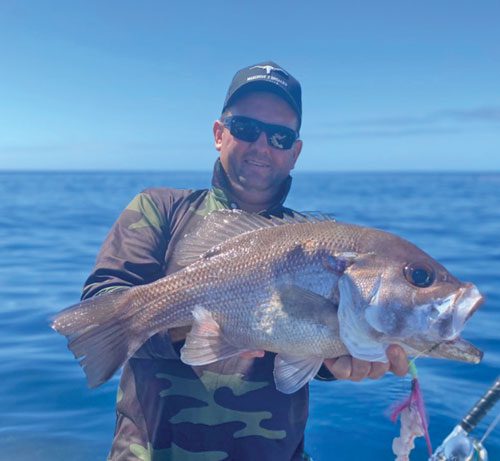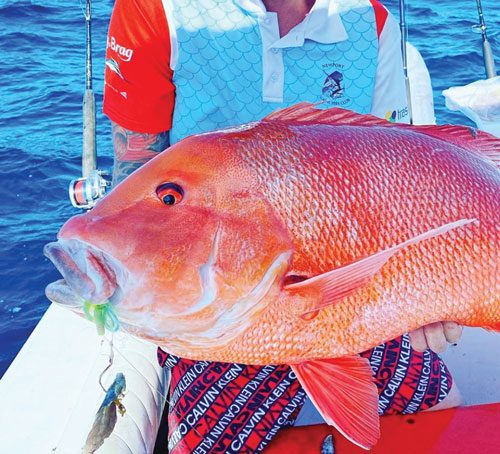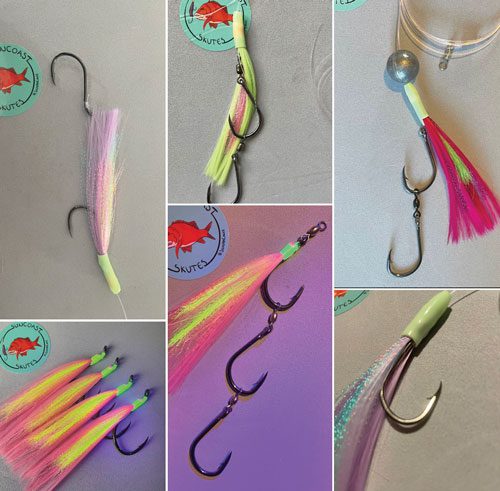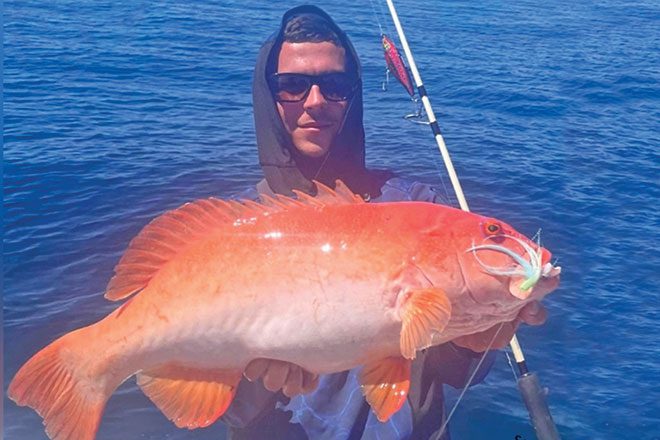Yes, that’s right, offshore flashing. flashers
But not as we normally associate flashing.
This month, I give a run down on the key practice of using ultraviolet and glow-enhanced flashers to change the way fish view a bait.
In essence, a flasher does what it says on the tin, but what’s the purpose other than sparkle?
The short answer is that it attracts attention and curiosity using colour, which – by adding a shimmering or scale-dropping motion – draws a committed bite.
This will only apply to fish that can actually see the flash and colour patterns – in shallow water or higher in the water column.
In which case, shallow water requires a bit of delicacy, with subtle natural colours that won’t look out of place to weary fish.
After a long hard think, I challenged the idea of flash being used offshore to attract more activity and whether it might be the most effective element to a flasher, as colour fades and sunlight dilutes in the depths.

After stacks of much-enjoyed research and development with great people, and online investigation over a few beverages, it was rewarding to finally land at a conclusion that tied into the product as a solid benchmark to stick to.
My conclusion was that the blended materials featuring a range of functions were far more effective than any store-bought flasher using 100 percent crystal flash fibre – which had less impact under UV light, did not glow and lacked a swimming motion due to the thicker shorter strands that tangled and kinked very easily.
Now that the colour, flash and glow ratio is out the way, let’s have a look at when and why these Esky-boosting goodies work in five simple outlooks.
First scenario – irregular bite times when you’ve already had success and the bite window has slowed down or when you are prospecting around on a slow day and feel the need to lift your game a touch.
This can be on the Great Barrier Reef, in and around the numerous bays such as Hervey and Moreton or along any southeast Queensland scattered reef lines.
When you’re fishing busy grounds, where imparting a bit of life into your bait can often mean the difference between fish on the barbecue with the family or lamb chops from the butcher.

Second – dawn and dusk periods when all three elements can work together in their own function over the course of session.
A great example is fishing for red emperor, when squid and hussar are prime targets for a feed.
When hussar are agitated and stressed, they illuminate their yellow flanks.
A deep pink with flash, laced with a streak of fluoro yellow and finished with a subtle glow will stand out and grab the attention of these prime targets.
Third – deeper water where fish are less concentrated and are generally covering more ground looking for a snack.
Target species quite often spend a bit of time looking up as well as scanning the bottom, so either way, when a fish that doesn’t mind swapping effort for reward can see a bait 10-15m before it would normally, it’s never a bad thing.
In an ideal world, when that fish is homing in, it has already made enough conscience decisions based on colour curiosity, lifelike motion, scale-drop simulation and finally smell, so you are going to experience a much harder committed hook-up rather than only an enquiry.
Colours can neutralise and alter the deeper they go, however let’s not forget that Queensland has stronger UV rays and will of course lend a favour to what fish can see down there, even if it is a burden to the daily life of skin care.
Fourth – faster drifts when fishing schooling fish can be great, if you have a bit of discipline to strike the harder hits while you let the pickers do your berley for you in the middle of say a school of pearl perch.

The flashers continue to fish once the bait’s gone and will often pick up sought after catches due to their lure-like action – which the pickers left alone after realising the bait was gone.
Bigger fish will wolf it, especially if it came off the bottom, leading up to the end of a drift in stronger current.
The faster you can tempt a fish, the less likely the flasher will pass it by – particularly a species that prefers to sit and wait for food to come to it before inhaling through its bucket mouth.
The same concept applies to coral trout – smaller bait that go quick will get hit once the pickers leave the flasher alone for a few seconds.
Trout enjoy stealing a meal from a fish or snatching the scrap before anything else has a chance to.
Hollow-core flashers have been sensational over the past couple of years, helping anglers to keep focus on where the hooks are and not the fragmented flesh bait.
And fifth – you can see the fish clear as day on the sounder but can’t get them to bite.
Sometimes it’s as simple as switching bait presentations and giving the fish a little something to stimulate them, whether it resembles characteristics of a squid or injured baitfish, it doesn’t matter if it works.
New charters or grounds with a group are usually the perfect opportunity to grab a flasher and turn a few heads.
Occasionally it’ll induce a touch of mocking but that’s OK because it often all goes quiet fairly quickly once the first fish comes over the side of the gunnel.
Bigger fish sitting deep – such as amberjack, kingfish and cobia – and the occasional pelagic – including marlin and tuna – are especially prone to smacking UV pinks, with a bit of colour tone contrasting against the background of the bottom or distance.
Have fun with this and don’t forget to send in photos of your catches if you’ve had success, with help from a few tweaks to how a fish views your bait.
Tight lines.
Suncoast Skutes
 Bush ‘n Beach Fishing Magazine Location reports & tips for fishing, boating, camping, kayaking, 4WDing in Queensland and Northern NSW
Bush ‘n Beach Fishing Magazine Location reports & tips for fishing, boating, camping, kayaking, 4WDing in Queensland and Northern NSW









